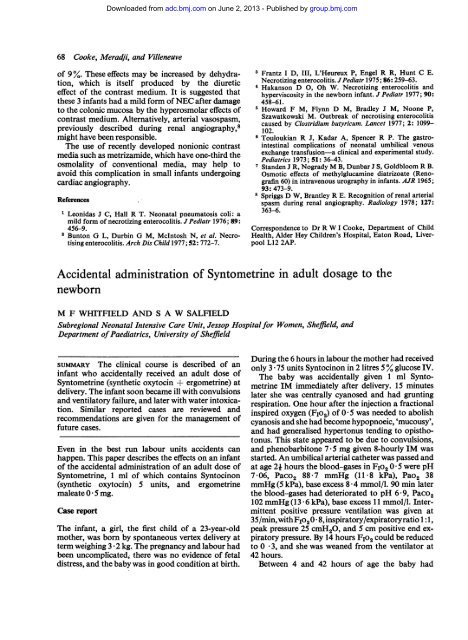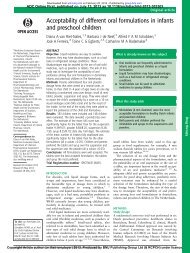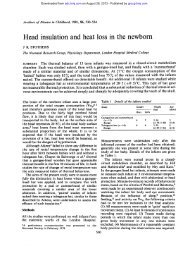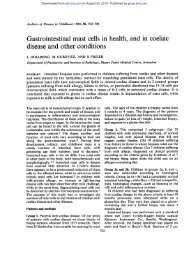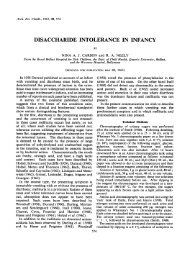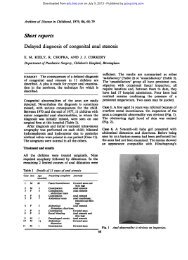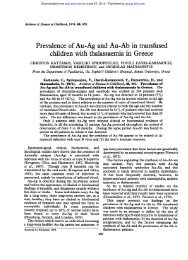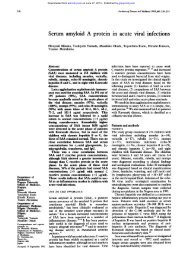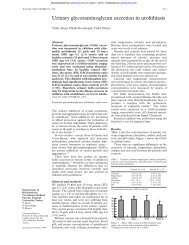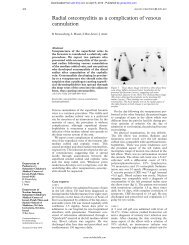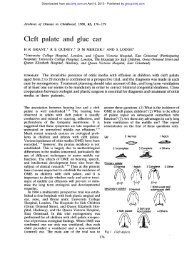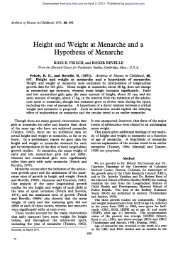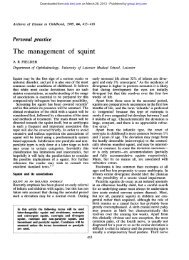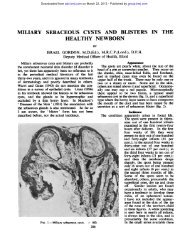Accidental administration of Syntometrine in adult dosage to the ...
Accidental administration of Syntometrine in adult dosage to the ...
Accidental administration of Syntometrine in adult dosage to the ...
Create successful ePaper yourself
Turn your PDF publications into a flip-book with our unique Google optimized e-Paper software.
68 Cooke, Meradji, and Villeneuve<br />
<strong>of</strong> 9 %. These effects may be <strong>in</strong>creased by dehydration,<br />
which is itself produced by <strong>the</strong> diuretic<br />
effect <strong>of</strong> <strong>the</strong> contrast medium. It is suggested that<br />
<strong>the</strong>se 3 <strong>in</strong>fants had a mild form <strong>of</strong> NEC after damage<br />
<strong>to</strong> <strong>the</strong> colonic mucosa by <strong>the</strong> hyperosmolar effects <strong>of</strong><br />
contrast medium. Alternatively, arterial vasospasm,<br />
previously described dur<strong>in</strong>g renal angiography,8<br />
might have been responsible.<br />
The use <strong>of</strong> recently developed nonionic contrast<br />
media such as metrizamide, which have one-third <strong>the</strong><br />
osmolality <strong>of</strong> conventional media, may help <strong>to</strong><br />
avoid this complication <strong>in</strong> small <strong>in</strong>fants undergo<strong>in</strong>g<br />
cardiac angiography.<br />
References<br />
Leonidas J C, Hall R T. Neonatal pneuma<strong>to</strong>sis coli: a<br />
mild form <strong>of</strong> necrotiz<strong>in</strong>g enterocolitis. JPediatr 1976; 89:<br />
456-9.<br />
2 Bun<strong>to</strong>n G L, Durb<strong>in</strong> G M, McIn<strong>to</strong>sh N, et al. Necrotis<strong>in</strong>g<br />
enterocolitis. Arch Dis Child 1977; 52: 772-7.<br />
3 Frantz I D, III, L'Heureux P, Engel R R, Hunt C E.<br />
Necrotiz<strong>in</strong>g enterocolitis. JPediatr 1975; 86: 259-63.<br />
4 Hakanson D 0, Oh W. Necrotiz<strong>in</strong>g enterocolitis and<br />
hyperviscosity <strong>in</strong> <strong>the</strong> newborn <strong>in</strong>fant. J Pediatr 1977; 90:<br />
458-61.<br />
5 Howard F M, Flynn D M, Bradley J M, Noone P,<br />
Szawatkowski M. Outbreak <strong>of</strong> necrotis<strong>in</strong>g enterocolitis<br />
caused by Clostridium butyricum. Lancet 1977; 2: 1099-<br />
102.<br />
6 Touloukian R J, Kadar A, Spencer R P. The gastro<strong>in</strong>test<strong>in</strong>al<br />
complications <strong>of</strong> neonatal umbilical venous<br />
exchange transfusion-a cl<strong>in</strong>ical and experimental study.<br />
Pediatrics 1973; 51: 3643.<br />
7 Standen J R, Nogrady M B, Dunbar J S, Goldbloom R B.<br />
Osmotic effects <strong>of</strong> methylglucam<strong>in</strong>e diatrizoate (Renograf<strong>in</strong><br />
60) <strong>in</strong> <strong>in</strong>travenous urography <strong>in</strong> <strong>in</strong>fants. AJR 1965;<br />
93: 473-9.<br />
8 Spriggs D W, Brantley R E. Recognition <strong>of</strong> renal arterial<br />
spasm dur<strong>in</strong>g renal angiography. Radiology 1978; 127:<br />
363-6.<br />
Correspondence <strong>to</strong> Dr R W I Cooke, Department <strong>of</strong> Child<br />
Health, Alder Hey Children's Hospital, Ea<strong>to</strong>n Road, Liverpool<br />
L12 2AP.<br />
<strong>Accidental</strong> <strong>adm<strong>in</strong>istration</strong> <strong>of</strong> <strong>Syn<strong>to</strong>metr<strong>in</strong>e</strong> <strong>in</strong> <strong>adult</strong> <strong>dosage</strong> <strong>to</strong> <strong>the</strong><br />
newborn<br />
M F WHITFIELD AND S A W SALFIELD<br />
Subregional Neonatal Intensive Care Unit, Jessop Hospital for Women, Sheffield, and<br />
Department <strong>of</strong>Paediatrics, University <strong>of</strong> Sheffield<br />
suMMARY The cl<strong>in</strong>ical course is described <strong>of</strong> an<br />
<strong>in</strong>fant who accidentally received an <strong>adult</strong> dose <strong>of</strong><br />
<strong>Syn<strong>to</strong>metr<strong>in</strong>e</strong> (syn<strong>the</strong>tic oxy<strong>to</strong>c<strong>in</strong> + ergometr<strong>in</strong>e) at<br />
delivery. The <strong>in</strong>fant soon became ill with convulsions<br />
and ventila<strong>to</strong>ry failure, and later with water <strong>in</strong><strong>to</strong>xication.<br />
Similar reported cases are reviewed and<br />
recommendations are given for <strong>the</strong> management <strong>of</strong><br />
future cases.<br />
Even <strong>in</strong> <strong>the</strong> best run labour units accidents can<br />
happen. This paper describes <strong>the</strong> effects on an <strong>in</strong>fant<br />
<strong>of</strong> <strong>the</strong> accidental <strong>adm<strong>in</strong>istration</strong> <strong>of</strong> an <strong>adult</strong> dose <strong>of</strong><br />
<strong>Syn<strong>to</strong>metr<strong>in</strong>e</strong>, 1 ml <strong>of</strong> which conta<strong>in</strong>s Syn<strong>to</strong>c<strong>in</strong>on<br />
(syn<strong>the</strong>tic oxy<strong>to</strong>c<strong>in</strong>) 5 units, and ergometr<strong>in</strong>e<br />
maleate 0 * 5 mg.<br />
Case report<br />
Downloaded from<br />
adc.bmj.com on June 2, 2013 - Published by group.bmj.com<br />
The <strong>in</strong>fant, a girl, <strong>the</strong> first child <strong>of</strong> a 23-year-old<br />
mo<strong>the</strong>r, was born by spontaneous vertex delivery at<br />
term weigh<strong>in</strong>g 3 * 2 kg. The pregnancy and labour had<br />
been uncomplicated; <strong>the</strong>re was no evidence <strong>of</strong> fetal<br />
distress, and <strong>the</strong> baby was <strong>in</strong> good condition at birth.<br />
Dur<strong>in</strong>g <strong>the</strong> 6 hours <strong>in</strong> labour <strong>the</strong> mo<strong>the</strong>r had received<br />
only 3 * 75 units Syn<strong>to</strong>c<strong>in</strong>on <strong>in</strong> 2 litres 5% glucose IV.<br />
The baby was accidentally given 1 ml <strong>Syn<strong>to</strong>metr<strong>in</strong>e</strong><br />
IM immediately after delivery. 15 m<strong>in</strong>utes<br />
later she was centrally cyanosed and had grunt<strong>in</strong>g<br />
respiration. One hour after <strong>the</strong> <strong>in</strong>jection a fractional<br />
<strong>in</strong>spired oxygen (Flo2) <strong>of</strong> 0 * 5 was needed <strong>to</strong> abolish<br />
cyanosis and she had become hypopnoeic, 'mucousy',<br />
and had generalised hyper<strong>to</strong>nus tend<strong>in</strong>g <strong>to</strong> opistho<strong>to</strong>nus.<br />
This state appeared <strong>to</strong> be due <strong>to</strong> convulsions,<br />
- and phenobarbi<strong>to</strong>ne 7 5 mg given 8-hourly IM was<br />
started. An umbilical arterial ca<strong>the</strong>ter was passed and<br />
at age 2j hours <strong>the</strong> blood-gases <strong>in</strong> Fo2 0 * 5 were pH<br />
7 * 06, Paco2 88 * 7 mmHg (11 * 8 kPa), Pao2 38<br />
mmHg (5 kPa), base excess 8 *4 mmol/l. 90 m<strong>in</strong> later<br />
<strong>the</strong> blood-gases had deteriorated <strong>to</strong> pH 6 9, Paco2<br />
- 102 mmHg (13 6 kPa), base excess 11 mmol/l. Intermittent<br />
positive pressure ventilation was given at<br />
35/m<strong>in</strong>,withF1o20 * 8, <strong>in</strong>spira<strong>to</strong>ry/expira<strong>to</strong>ryratio 1: 1,<br />
peak pressure 25 cmH20, and 5 cm positive end expira<strong>to</strong>ry<br />
pressure. By 14 hours F1O2 could be reduced<br />
<strong>to</strong> 0 3, and she was weaned from <strong>the</strong> ventila<strong>to</strong>r at<br />
42 hours.<br />
Between 4 and 42 hours <strong>of</strong> age <strong>the</strong> baby had
generalised convulsions and received diazepam 5 mg,<br />
phenobarbi<strong>to</strong>ne 45 mg, and paraldehyde 0 5 ml.<br />
At <strong>the</strong> onset <strong>of</strong> convulsions <strong>the</strong> plasma calcium,<br />
magnesium, urea, and electrolytes and <strong>the</strong> blood<br />
glucose levels were all normal.<br />
No ur<strong>in</strong>e was passed until 19 hours and by 48<br />
hours her weight was 180 g above birthweight,<br />
with gross oedema, and serum Na 102 mmol/l.<br />
Fluid <strong>in</strong>take (10% glucose) <strong>in</strong> <strong>the</strong> first 24 hours was<br />
60 mi/kg and <strong>in</strong> <strong>the</strong> second 24 hours 76 ml/kg. The<br />
course <strong>of</strong> plasma electrolyte and ur<strong>in</strong>e osmolality<br />
measurements is summarised <strong>in</strong> <strong>the</strong> Table.<br />
Table Changes <strong>in</strong> plasma electrolytes and ur<strong>in</strong>ary<br />
osmolality dur<strong>in</strong>g <strong>the</strong> first 4 days <strong>of</strong> life<br />
Age (days) Plasma sodium Plasma chloride Ur<strong>in</strong>e osmolality<br />
(mmol/l) (mmol/l) (mmol/kg)<br />
1 129 94 358<br />
2 102 75 423<br />
213<br />
147<br />
111<br />
4 127 87 150<br />
O<strong>the</strong>r <strong>in</strong>vestigations <strong>in</strong>cluded normal platelet,<br />
differential and neutrophil counts, and a normal<br />
coagulation screen on two occasions <strong>in</strong> <strong>the</strong> first 4<br />
days <strong>of</strong> life. Dextrostix ranged between 45 and 90<br />
mg/100 ml <strong>in</strong> <strong>the</strong> first 36 hours (5 measurements).<br />
Breast feed<strong>in</strong>g was established by <strong>the</strong> 5th day and<br />
<strong>the</strong> baby discharged at 7 days <strong>of</strong> age. Subsequent<br />
follow-up, so far <strong>to</strong> one year, has shown a developmentally<br />
normal <strong>in</strong>fant perform<strong>in</strong>g better than<br />
average for age, with normal neurological exam<strong>in</strong>ation,<br />
hear<strong>in</strong>g, and eyesight.<br />
Discussion<br />
Downloaded from<br />
adc.bmj.com on June 2, 2013 - Published by group.bmj.com<br />
Two previous cases <strong>of</strong> accidential <strong>adm<strong>in</strong>istration</strong> <strong>of</strong><br />
<strong>Syn<strong>to</strong>metr<strong>in</strong>e</strong> have been recorded12 both receiv<strong>in</strong>g<br />
1 ml. The 2* 84-kg <strong>in</strong>fant described by Kenna1<br />
developed respira<strong>to</strong>ry depression with<strong>in</strong> half an hour<br />
and required mechanical ventilation at 2 hours for<br />
<strong>the</strong> next 50 hours. Convulsions began at 3 hours and<br />
<strong>the</strong>se were treated with phenobarbi<strong>to</strong>ne and<br />
diazepam. At 18 months <strong>of</strong> age <strong>the</strong> baby was<br />
neurologically normal. This case is similar <strong>to</strong> ours.<br />
- Brere<strong>to</strong>n-Stiles2 described an <strong>in</strong>fant <strong>of</strong> 3 5<br />
<strong>Accidental</strong> <strong>adm<strong>in</strong>istration</strong> <strong>of</strong> <strong>Syn<strong>to</strong>metr<strong>in</strong>e</strong> <strong>in</strong> <strong>adult</strong> <strong>dosage</strong> <strong>to</strong> <strong>the</strong> newborn 69<br />
kg who<br />
developed 'myoclonic seizures' and respira<strong>to</strong>ry<br />
depression with<strong>in</strong> 2 hours <strong>of</strong> <strong>the</strong> <strong>in</strong>jection. The<br />
myoclonic seizures were treated with chlorpromaz<strong>in</strong>e<br />
and <strong>the</strong> baby's respira<strong>to</strong>ry state rema<strong>in</strong>ed satisfac<strong>to</strong>ry<br />
<strong>in</strong> F1O2 0 3 until 6 hours <strong>of</strong> age when a brief period<br />
<strong>of</strong> manual ventilation was required. She was much<br />
improved by 24 hours <strong>of</strong> age and normal at 4 days.<br />
No follow-up is reported.<br />
Two fur<strong>the</strong>r cases have been notified <strong>to</strong> Sandoz<br />
(<strong>the</strong> manufacturers <strong>of</strong> <strong>the</strong> drug) from F<strong>in</strong>land who<br />
exhibited sk<strong>in</strong> flush<strong>in</strong>g and cardiac arrhythmias;<br />
both recovered. In one o<strong>the</strong>r case (known <strong>to</strong> <strong>the</strong><br />
Poisons Information Centre at Guy's Hospital,<br />
London) <strong>the</strong> baby developed respira<strong>to</strong>ry arrest and<br />
required ventilat<strong>in</strong>g for 12 hours. He was also<br />
hyper<strong>to</strong>nic and had peripheral vasoconstriction <strong>of</strong><br />
one foot but made a full recovery.<br />
<strong>Syn<strong>to</strong>metr<strong>in</strong>e</strong> is widely used <strong>in</strong> <strong>the</strong> management <strong>of</strong><br />
<strong>the</strong> third stage <strong>of</strong> labour <strong>to</strong> reduce postpartum<br />
haemorrhage,3 oxy<strong>to</strong>c<strong>in</strong> produc<strong>in</strong>g a rapid but<br />
unsusta<strong>in</strong>ed uter<strong>in</strong>e contraction, while ergometr<strong>in</strong>e<br />
produces a prolonged contraction <strong>of</strong> slower onset.<br />
Effects <strong>of</strong> over<strong>dosage</strong> with ergometr<strong>in</strong>e are vascular<br />
smooth muscle spasm, hypertension and depression<br />
<strong>of</strong> <strong>the</strong> central nervous system particularly <strong>of</strong> <strong>the</strong><br />
respira<strong>to</strong>ry centre, and convulsions. Syn<strong>to</strong>c<strong>in</strong>on can<br />
produce hypotension and <strong>in</strong> overdose, even <strong>the</strong><br />
syn<strong>the</strong>tic form <strong>of</strong> oxy<strong>to</strong>c<strong>in</strong> has an antidiuretic effect.<br />
There have been reports <strong>of</strong> hyponatraemia and<br />
convulsions <strong>in</strong> <strong>the</strong> newborn baby due <strong>to</strong> apparent<br />
<strong>in</strong>ability <strong>of</strong> <strong>the</strong> mo<strong>the</strong>r <strong>to</strong> excrete a fluid load while<br />
receiv<strong>in</strong>g an oxy<strong>to</strong>c<strong>in</strong> drip dur<strong>in</strong>g labour.45<br />
Our <strong>in</strong>fant received about 20 times <strong>the</strong> <strong>adult</strong><br />
<strong>dosage</strong> <strong>of</strong> <strong>Syn<strong>to</strong>metr<strong>in</strong>e</strong> <strong>in</strong> terms <strong>of</strong> body weight. The<br />
cl<strong>in</strong>ical problems were convulsions and respira<strong>to</strong>ry<br />
depression caused by ergometr<strong>in</strong>e, and dilutional<br />
hyponatraemia due <strong>to</strong> <strong>the</strong> antidiuretic effect <strong>of</strong> a<br />
very large dose <strong>of</strong> oxy<strong>to</strong>c<strong>in</strong> despite a conservative<br />
fluid <strong>in</strong>take. The mo<strong>the</strong>r received only a small dose <strong>of</strong><br />
oxy<strong>to</strong>c<strong>in</strong> dur<strong>in</strong>g labour and it seems unlikely that<br />
this was a contribu<strong>to</strong>ry fac<strong>to</strong>r. Artificial ventilation<br />
with positive end expira<strong>to</strong>ry pressure might also<br />
have contributed <strong>to</strong> an <strong>in</strong>appropriate antidiuretic<br />
effect, but <strong>the</strong> severity <strong>in</strong> this case far exceeded our<br />
previous experience with ventilation alone. Cerebral<br />
oedema might also have contributed <strong>to</strong> <strong>the</strong> difficulty<br />
<strong>in</strong> controll<strong>in</strong>g her convulsions.<br />
The <strong>in</strong>itial requirement <strong>of</strong> high F1o2 and ventilation<br />
pressures, and <strong>the</strong> long <strong>in</strong>spira<strong>to</strong>ry time suggest<br />
pulmonary vascular spasm which relaxed after 14<br />
hours. Provided blood pressure can be adequately<br />
moni<strong>to</strong>red, pulmonary arterial dila<strong>to</strong>rs-such as<br />
<strong>to</strong>lazol<strong>in</strong>e (1-2 mg/kg TV)6 or nitroprusside (2 ,ug/kg<br />
per m<strong>in</strong>)7-might be <strong>of</strong> benefit <strong>in</strong> future cases where<br />
adequate oxygenation is a problem <strong>in</strong> <strong>the</strong> first few<br />
hours, despite ventilation. Muscular hyper<strong>to</strong>nicity<br />
and convulsions also contribute <strong>to</strong> <strong>the</strong> difficulties <strong>in</strong><br />
respira<strong>to</strong>ry management.<br />
Because <strong>of</strong> <strong>the</strong> acute nature <strong>of</strong> <strong>the</strong> problem, an<br />
account <strong>of</strong> accidental <strong>Syn<strong>to</strong>metr<strong>in</strong>e</strong> poison<strong>in</strong>g<br />
should be given <strong>in</strong> all neona<strong>to</strong>logy textbooks. At<br />
present it is difficult <strong>to</strong> get <strong>in</strong>formation quickly about<br />
<strong>the</strong> likely course <strong>of</strong> events.
70 Whitfield and Salfield<br />
We thank <strong>the</strong> Poisons Information Centre at Guy's<br />
Hospital London, and Sandoz Products Limited, for<br />
<strong>the</strong>ir swift co-operation <strong>in</strong> <strong>the</strong> management <strong>of</strong> this<br />
case, and Dr J A Black for permission <strong>to</strong> report it.<br />
References<br />
1 Kenna A P. <strong>Accidental</strong> adm<strong>in</strong>stration <strong>of</strong> <strong>Syn<strong>to</strong>metr<strong>in</strong>e</strong><br />
<strong>to</strong> a newborn <strong>in</strong>fant. Br J Obstet Gynaecol 1972; 79: 764-6.<br />
2 Brere<strong>to</strong>n-Stiles G C, W<strong>in</strong>ship W S, Goodw<strong>in</strong> N M, Roos<br />
R F. Letter: <strong>Accidental</strong> <strong>adm<strong>in</strong>istration</strong> <strong>of</strong> <strong>Syn<strong>to</strong>metr<strong>in</strong>e</strong><br />
<strong>to</strong> a neonate. S Afr MedJ 1972; 46: 2052.<br />
3 Embrey M P, Barber D T C, Scudamore J H. Use <strong>of</strong><br />
<strong>Syn<strong>to</strong>metr<strong>in</strong>e</strong> <strong>in</strong> prevention <strong>of</strong> post-partum haemorrhage.<br />
Br MedJ 1963; 1: 1387-9.<br />
4 Schwartz R H, Jones R W A. (1978) Transplacental<br />
hyponatraemia due <strong>to</strong> oxy<strong>to</strong>c<strong>in</strong>. Br MedJ 1978; 1: 152-3.<br />
5 Vere M F, Sellers S M. Letter: Transplacental hyponatraemia<br />
due <strong>to</strong> oxy<strong>to</strong>c<strong>in</strong>. Br MedJ 1978; 1: 362.<br />
6 McIn<strong>to</strong>sh N, Walters R 0. Effect <strong>of</strong> <strong>to</strong>lazol<strong>in</strong>e <strong>in</strong> severe<br />
hyal<strong>in</strong>e membrane disease. Arch Dis Child 1979; 54:<br />
105-10.<br />
7 Abbott T R, Rees G J, Dick<strong>in</strong>son D, Reynolds G, Lord D.<br />
Sodium nitroprusside <strong>in</strong> idiopathic respira<strong>to</strong>ry distress<br />
syndrome. Br Med J 1978; 1: 11 13-4.<br />
Correspondence <strong>to</strong> Dr M F Whitfield, Subregional Neonatal<br />
Intensive Care Unit, Jessop Hospital for Women, Leavygreave<br />
Road, Sheffield S3 7RE.<br />
Prostagland<strong>in</strong> syn<strong>the</strong>tase <strong>in</strong>hibi<strong>to</strong>r <strong>in</strong> an <strong>in</strong>fant with congenital chloride<br />
diarrhoea<br />
ADRIAN M B MINFORD AND DAVID G D BARR<br />
Royal Hospital for Sick Children, Ed<strong>in</strong>burgh<br />
SUMMARY Hyper-ren<strong>in</strong>aemia, hypokaluria, and<br />
hypokalaemia <strong>in</strong> an <strong>in</strong>fant with congenital chloride<br />
diarrhoea improved dur<strong>in</strong>g treatment with a prostagland<strong>in</strong><br />
syn<strong>the</strong>tase <strong>in</strong>hibi<strong>to</strong>r, ke<strong>to</strong>pr<strong>of</strong>en. There was<br />
evidence <strong>of</strong> <strong>in</strong>creased activity <strong>of</strong> <strong>the</strong>ren<strong>in</strong>-aldosterone<br />
system when ke<strong>to</strong>pr<strong>of</strong>en was s<strong>to</strong>pped. It is suggested<br />
that prostagland<strong>in</strong>s may be <strong>in</strong>volved <strong>in</strong> stimulat<strong>in</strong>g<br />
<strong>the</strong> ren<strong>in</strong>-aldosterone system <strong>in</strong> congenital chloride<br />
diarrhoea.<br />
In congenital chloride diarrhoea, juxtaglomerular<br />
hyperplasia, hyper-ren<strong>in</strong>aemia, and hyperaldosteronism<br />
(with normal blood pressure), lead<strong>in</strong>g<br />
<strong>to</strong> hyperkaluria and hypokalaemia, complicate and<br />
worsen electrolyte imbalance and may predispose <strong>to</strong><br />
vascular damage and fur<strong>the</strong>r nephropathy.8<br />
These features are also present <strong>in</strong> Bartter's syndrome<br />
<strong>in</strong> which <strong>in</strong>creased renal production <strong>of</strong> prostagland<strong>in</strong>s<br />
has been implicated and a favourable response <strong>to</strong><br />
prostagland<strong>in</strong> syn<strong>the</strong>tase <strong>in</strong>hibi<strong>to</strong>rs described.1-3<br />
The cl<strong>in</strong>ical and biochemical effects <strong>of</strong> <strong>the</strong> prostagland<strong>in</strong><br />
syn<strong>the</strong>tase <strong>in</strong>hibi<strong>to</strong>r, ke<strong>to</strong>pr<strong>of</strong>en, are<br />
reported <strong>in</strong> an <strong>in</strong>fant with congenital chloride<br />
diarrhoea.<br />
Case report<br />
Downloaded from<br />
adc.bmj.com on June 2, 2013 - Published by group.bmj.com<br />
A Nigerian boy <strong>of</strong> 2 -42 kg was born at 33 weeks'<br />
gestation by normal delivery after a pregnancy<br />
complicated by hydramnios. At 12 hours he<br />
developed watery diarrhoea and abdom<strong>in</strong>al distension.<br />
He became dehydrated and hyponatraemic<br />
(serum Na 119 mmol/l, K 4-3 mmol/l, urea 10-3<br />
mmol/l; 62 mg/100 ml). He was given <strong>in</strong>travenous<br />
fluids and <strong>the</strong> diarrhoea settled after 2 weeks.<br />
S<strong>to</strong>ol electrolytes were not estimated. After discharge<br />
at 4 weeks, abdom<strong>in</strong>al distension persisted although<br />
he was ga<strong>in</strong><strong>in</strong>g weight and had no apparent<br />
diarrhoea. However, at 4 months his weight had<br />
fallen
Downloaded from<br />
adc.bmj.com on June 2, 2013 - Published by group.bmj.com<br />
References<br />
Email alert<strong>in</strong>g<br />
service<br />
Notes<br />
<strong>Accidental</strong> <strong>adm<strong>in</strong>istration</strong> <strong>of</strong><br />
<strong>Syn<strong>to</strong>metr<strong>in</strong>e</strong> <strong>in</strong> <strong>adult</strong> <strong>dosage</strong> <strong>to</strong><br />
<strong>the</strong> newborn.<br />
M F Whitfield and S A Salfield<br />
Arch Dis Child 1980 55: 68-70<br />
doi: 10.1136/adc.55.1.68<br />
Updated <strong>in</strong>formation and services can be found at:<br />
http://adc.bmj.com/content/55/1/68<br />
These <strong>in</strong>clude:<br />
Article cited <strong>in</strong>:<br />
http://adc.bmj.com/content/55/1/68#related-urls<br />
To request permissions go <strong>to</strong>:<br />
http://group.bmj.com/group/rights-licens<strong>in</strong>g/permissions<br />
To order repr<strong>in</strong>ts go <strong>to</strong>:<br />
http://journals.bmj.com/cgi/repr<strong>in</strong>tform<br />
To subscribe <strong>to</strong> BMJ go <strong>to</strong>:<br />
http://group.bmj.com/subscribe/<br />
Receive free email alerts when new articles cite this<br />
article. Sign up <strong>in</strong> <strong>the</strong> box at <strong>the</strong> <strong>to</strong>p right corner <strong>of</strong> <strong>the</strong><br />
onl<strong>in</strong>e article.


